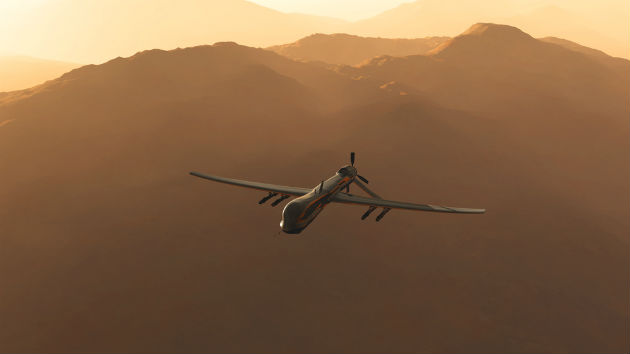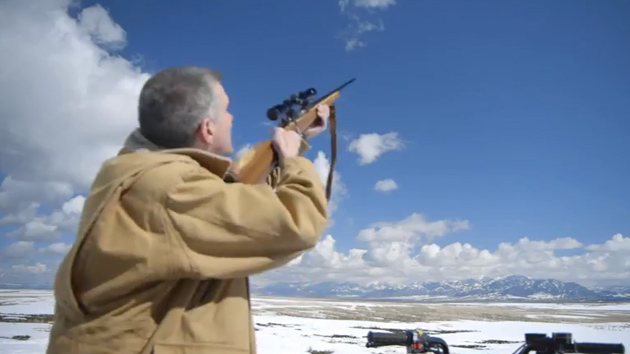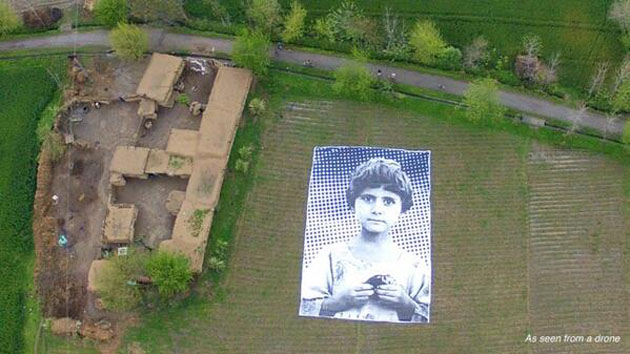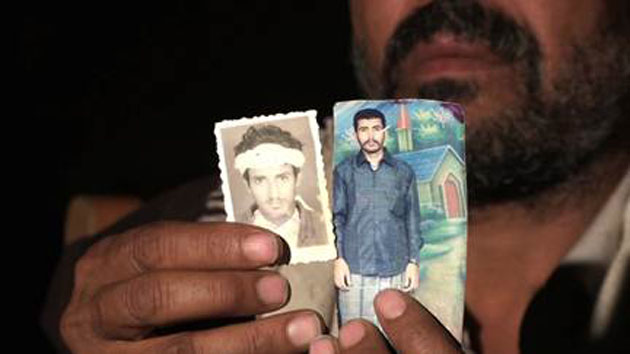
<a href="http://www.shutterstock.com/pic-167360990/stock-photo-predator-type-rq-drones-d-artwork.html?src=pp-same_artist-167361038-dWsx6BWq6JGeiSuMLRAwXA-6">Boscorelli</a>/Shutterstock
This story first appeared on the TomDispatch website.
Enemies, innocent victims, and soldiers have always made up the three faces of war. With war growing more distant, with drones capable of performing on the battlefield while their “pilots” remain thousands of miles away, two of those faces have, however, faded into the background in recent years. Today, we are left with just the reassuring “face” of the terrorist enemy, killed clinically by remote control while we go about our lives, apparently without any “collateral damage” or danger to our soldiers. Now, however, that may slowly be changing, bringing the true face of the drone campaigns Washington has pursued since 9/11 into far greater focus.
Imagine if those drone wars going on in Pakistan and Yemen (as well as the United States) had a human face all the time, so that we could understand what it was like to live constantly, in and out of those distant battle zones, with the specter of death. In addition to images of the “al-Qaeda” operatives who the White House wants us to believe are the sole targets of its drone campaigns, we would regularly see photos of innocent victims of drone attacks gathered by human rights groups from their relatives and neighbors. And what about the third group— the military personnel whose lives revolve around killing fields so far away—whose stories, in these years of Washington’s drone assassination campaigns, we’ve just about never heard?
![]() After all, soldiers no longer set sail on ships to journey to distant battlefields for months at a time. Instead, every day, thousands of men and women sign onto their computers at desks on military bases in the continental United States and abroad where they spend hours glued to screens watching the daily lives of people often on the other side of the planet. Occasionally, they get an order from Washington to push a button and vaporize their subjects. It sounds just like—and the comparison has been made often enough—a video game, which can be switched off at the end of a shift, after which those pilots return home to families and everyday life.
After all, soldiers no longer set sail on ships to journey to distant battlefields for months at a time. Instead, every day, thousands of men and women sign onto their computers at desks on military bases in the continental United States and abroad where they spend hours glued to screens watching the daily lives of people often on the other side of the planet. Occasionally, they get an order from Washington to push a button and vaporize their subjects. It sounds just like—and the comparison has been made often enough—a video game, which can be switched off at the end of a shift, after which those pilots return home to families and everyday life.
And if you believed what little we normally see of them—what, that is, the Air Force has let us see (the CIA part of the drone program being off-limits to news reporting)—that would indeed seem to be the straightforward story of life for our drone warriors. Take Rene Lopez, who in shots of a recent homecoming welcome at Fort Gordon in Georgia appears to be a doting father. Photographed for the local papers on his return from a tour in Afghanistan, the young soldier is seen holding and kissing his infant daughter dressed in a bright pink top. He smiles with delight as the wide-eyed child tries on his military hat.
From an online profile posted to LinkedIn by Lopez last year, we learn that the clean-cut US Army signals intelligence specialist claims to be an actor in the drone war in addition to being a proud parent. To be specific, he says he has been working in the dark arts of hunting and killing “high value targets” using a National Security Agency (NSA) tool known as Gilgamesh.
That tool is named after a ruthless Sumerian king who ruled over Uruk, an ancient city in what is now Iraq. With the help of the massive trove of NSA documents leaked by Edward Snowden, Glenn Greenwald and Jeremy Scahill recently explained that Gilgamesh is the code name for a special device mounted on a Predator drone that can track the mobile phones of individuals without their knowledge by pretending to be a cell phone tower.
Lopez’s resumé yields more details on what Gilgamesh is capable of. The profile writer claims that he “supervised a team of four personnel supporting the lead targeting force in Laghman and Nuristan provinces [in Afghanistan]. Assisted top-level commanders with developing concepts, approaches, and strategies to Capture/Kill HVTs [high value targets].”
Last year, on completing his time in the military, Lopez says he took a civilian job operating Gilgamesh for Mission Essential, an intelligence contractor providing technical support for Pentagon drones. For that company, he says he conducted “pattern of life analysis” and provided support for “targeting and strike operations.” Lopez lives in Grovetown, Georgia, home to a joint Army-NSA code-breaking and language translation operation, involving 4,000 personnel that, since 9/11, has taken the lead in analyzing real-time data feeds from Central Asia and the Middle East.
Gilgamesh is just one of several NSA tools used on drones to track targeted cell phones. Another program, Shenanigans, was designed specifically for use by the Central Intelligence Agency. According to other documents leaked by Snowden, an operation code-named Victorydance used these tools in March 2012 to map every computer, router, and mobile device in Yemen.
What do men like Lopez actually think about the sort of human destruction, not to speak of the destabilization of whole regions, that Gilgamesh and its like help to unleash? In his online job pitch, Lopez indicates straightforward pride in his work: “My efforts, both as a contractor and in the military, yielded success in identifying, locating, and tracking high value targets, and protection of US and coalition forces.” It would be easy enough to assume that the kind of analytical work such remote pilots do would result in a sense of job satisfaction and little more. And that, it turns out, would be a mistake.
Haunted by Death
In recent months, the first evidence that drones are not only killing thousands in distant lands, but also creating an unexpected kind of blowback among the pilots themselves, provides a curious parallel to the Epic of Gilgamesh, the 5,000-year-old poem about the Sumerian king. In the ancient saga, the gods are said to have sent Enkidu to befriend the cruel king and divert him from the oppression of his subjects. When the pair travel together to slay a monster named Humbaba, Gilgamesh begins to have nightmares about death and war, causing him to question their plan.
Today, like Gilgamesh of old, signals intelligence personnel connected to the drone programs have started reporting themselves haunted by the deaths that they have participated in, and plagued by the knowledge that, in the end, they often had next to no idea who they were actually killing. The publicity about a “kill list” in the White House has left the impression that those who find themselves on the other end of a drone-launched missile have been carefully identified and are known to the drone pilots. “People get hung up that there’s a targeted list of people,” one drone pilot told the Intercept two months ago. His view, however, was quite different: “It’s really like we’re targeting a cell phone. We’re not going after people—we’re going after their phones, in the hopes that the person on the other end of that missile is the bad guy.”
 Brandon Bryant, a 28-year-old US airman, whose squadron has been credited with 1,626 kills, was among the first to be openly critical of the impact of remote tracking and targeting, of, that is, robot war. Bryant was a “sensor operator,” which meant that he operated the cameras on the drone aircraft as part of a three-person team that included a pilot and an intelligence analyst.
Brandon Bryant, a 28-year-old US airman, whose squadron has been credited with 1,626 kills, was among the first to be openly critical of the impact of remote tracking and targeting, of, that is, robot war. Bryant was a “sensor operator,” which meant that he operated the cameras on the drone aircraft as part of a three-person team that included a pilot and an intelligence analyst.
In an interview with GQ magazine last October, Bryant offered a vivid description of a targeting operation in Afghanistan he took part in when he was just 21. “This figure runs around the corner, the outside, toward the front of the building. And it looked like a little kid to me. Like a little human person,” he said. “There’s this giant flash, and all of a sudden there’s no person there.”
Bryant says he asked the pilot: “Did that look like a child to you?” The message came back from another intelligence analyst: “Per the review, it’s a dog.”
After six years, Bryant couldn’t take it any more. He saw a therapist who diagnosed him with post-traumatic stress disorder. This was a novel, even shocking development for an airman who had hardly ever come close to a battlefield. Bryant was suitably taken aback and, as a result, began speaking out against the system of killing he had been enmeshed in and what it does both to the killers and those killed. “Combat is combat. Killing is killing. This isn’t a video game,” he wrote in an angry tirade on Facebook. “How many of you have killed a group of people, watched as their bodies are picked up, watched the funeral, then killed them, too?”
Killing for the CIA
Bryant’s campaign against drone war without accountability took on new life in late April when Tonje Hessen Schei, a Norwegian filmmaker, released her film Drone. In it, Bryant reveals that his former colleagues in the Air Force had not just been carrying out drone strikes on the battlefields of Afghanistan and Iraq where the military was involved in open warfare. They were also conducting the strikes in the supposed CIA drone assassination campaigns in Pakistan and Yemen.
This was news. The CIA’s “covert” drone wars in those countries were, it turns out, secretly Air Force operations. “The CIA might be the customer, but the Air Force has always flown it,” Bryant says in the film. “A CIA label is just an excuse to not have to give up any information. That is all it has ever been.”
Schei’s film also reveals the name of the US Air Force unit that does the CIA killing—the 17th Reconnaissance Squadron at Creech Air Force Base in Nevada. “From what I was able to gather, it was pretty much confirmed they were flying missions almost exclusively in Pakistan with the intent to strike,” Michael Haas, another drone pilot, told Chris Woods at the Guardian.
Thanks to the film, Bryant made an unusual connection in the world of drone pilots—to the victims of Washington’s drone campaign, previously just so many pixels on a screen to him. Invited to Belgium and Norway to speak at the premieres of Schei’s film, he met with Shahzad Akbar, a Pakistani lawyer who runs the Foundation for Fundamental Rights and has been leading a campaign to put a face—quite literally—on the death and destruction CIA drone strikes have caused in his country.
Faces of the Victims
Up in the mountains of Khyber Pakhtunkhwa in northern Pakistan, a giant image of an orphan girl is now laid out next to the mud houses of the locals. She is nameless, but according to her photographer, Noor Behram, she lost her parents in a drone strike in 2010 in the village of Dande Darpa Khel. Her picture, the size of a soccer playing field, is a product of Akbar’s planning with the help of JR, a French street artist, and Clive Stafford-Smith, the founder of Reprieve, a British human rights organization. Their intent: to create images of the victims of Washington’s drone wars that could be seen from the sky. Smaller images have, in fact, been placed on rooftops in Waziristan. Their target audience: drone pilots like Bryant, Haas, and Lopez who, searching for targets to kill, might just see the face of the child of one of their previous victims. (The Bureau of Investigative Journalism, which keeps a tally of drone victims in Pakistan, offers a provisional figure of up to 957 civilians, including as many as 202 children, killed between 2004 and the present day.)
For the last five years, Akbar and Smith have worked tirelessly on similar projects. One of their first efforts was to reveal the name of the CIA station chief in Pakistan: Jonathan Banks. In December 2010, they brought a $500 million lawsuit against him in that country, causing him to flee. The next summer they put together a collection of Noor Behram’s photographs of the dead, as well as their relatives and neighbors, that was exhibited in London.
Last year, Akbar even made plans to take the relatives of drone victims to testify before the US Congress. Though he himself was denied entry to the country, he succeeded. Rafiq-ur-Rehman and his two children, nine-year-old Nabila-ur-Rehman and 13-year-old Zubair-ur-Rehman, did speak at a special hearing arranged by Representative Alan Grayson.
Now, with the unexpected support of a small but growing group of former drone pilots, a campaign against “targeted killings” might well take on a new life in the US At least six other drone pilots have already spoken anonymously to Woods, largely confirming what Bryant and Haas have said publicly.
The Strain of Long-Distance War
There is evidence that other drone pilots are also beginning to crack under the pressure of drone war. Two recent studies by the Air Force strongly suggest that Bryant’s PTSD diagnosis is no anomaly, that no matter how far you may be from the battlefield, you never quite leave it.
Published in June 2011, the first study by Wayne Chappelle, Joseph Ouma, and Amber Salinas of the School of Aerospace Medicine at Wright-Patterson Air Force Base in Ohio concluded that nearly half of the drone pilots studied had “high operational stress.” A number also had “clinical distress”—that is, anxiety, depression, or stress severe enough to affect them in their personal lives. The study attributed this to long “flying” hours and erratic shifts, but did not compare drone pilots to those in combat aircraft fighting above the battlefield.
A second study by Jean Otto and Bryant Webber of the Armed Forces Health Surveillance Center and the Uniformed Services University of the Health Sciences, published in March 2013, compared drone pilots to those performing standard military missions. The level of stress, it found, was almost the same, a surprising conclusion for those who assumed that drone pilots were essentially video gamers.
“Remotely piloted aircraft pilots may stare at the same piece of ground for days,” Otto told the New York Times. “They witness the carnage. Manned aircraft pilots don’t do that. They get out of there as soon as possible.”
Some believe that drone stress is significantly related to a major shortage of pilots for such planes. A Government Accountability Office report released in April tersely notes that “high work demands on RPA [remotely piloted aircraft] pilots limit the time they have available for training and development and negatively affects their work-life balance.”
Speaking from the Heavens
There is, however, likely to be far more to it than that. After Bryant came forward, for instance, Heather Linebaugh, a former drone intelligence analyst, broke her silence, too. Writing in the Guardian in late December, she summed up the largely unpublicized failure of Washington’s drones this way: “What the public needs to understand is that the video provided by a drone is not usually clear enough to detect someone carrying a weapon, even on a crystal-clear day with limited cloud and perfect light. The feed is so pixelated, what if it’s a shovel, and not a weapon? We always wonder if we killed the right people, if we destroyed an innocent civilian’s life all because of a bad image or angle.” (And she didn’t even point out that, in the areas being attacked in Pakistan and Yemen, carrying a weapon is commonplace and not necessarily a sign that you are a “terrorist.”)
Linebaugh explained that, under these circumstances, a “mistake” had terrible consequences, and not just for those erroneously targeted, but even for the pilots. “How many women and children have you seen incinerated by a Hellfire missile? How many men have you seen crawl across a field, trying to make it to the nearest compound for help while bleeding out from severed legs?” She added, “When you are exposed to it over and over again it becomes like a small video, embedded in your head, forever on repeat, causing psychological pain and suffering that many people will hopefully never experience.”
And don’t count on Linebaugh being the last drone analyst to speak out, either. Whether future Rene Lopezes ever actually look down from the computerized “heavens” and see the picture of that little Pakistani orphan girl, we already know that they will see horrors that are likely to prove hard to absorb.
It is this third face of war, along with those of the “enemy” and innocent victims, which provides the crucial evidence that the drone project, Obama’s remote control campaign, is a failure; that it is not clinical but bloody and riddled with error; that it creates enemies even as it kills others; that it is, above all, no more a video game for those who fly the planes and loose the missiles than it is for those who die in distant lands.
Pratap Chatterjee, a TomDispatch regular, is executive director of CorpWatch and a board member of Amnesty International USA. He is the author of Halliburton’s Army and Iraq, Inc.
Follow TomDispatch on Twitter and join us on Facebook and Tumblr. Check out the newest Dispatch Book, Ann Jones’s They Were Soldiers: How the Wounded Return From America’s Wars—The Untold Story. To stay on top of important articles like these, sign up to receive the latest updates from TomDispatch.com here.











